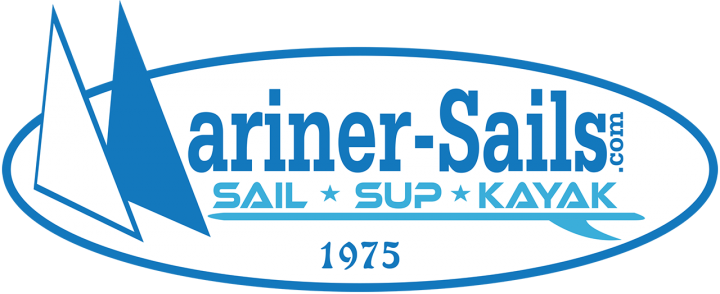Intro to Windsurfing
- Posted on
- Posted in WINDSURFING
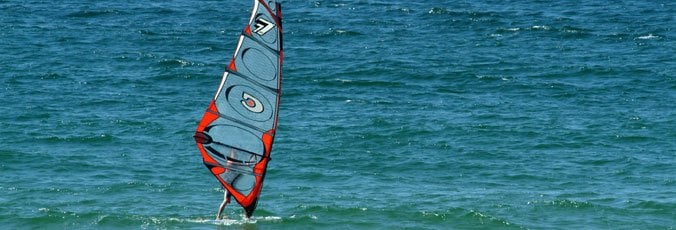
What is Windsurfing?
In brief, windsurfing (also known as Sailboarding) is a water sport using a board powered by the force of the wind. Windsurfing is an extremely pure, if not the purest, form of sailing. A windsurfer uses his or her body as a conduit for the natural force of the wind which propels the board.
Unlike surfing, where only the wave is the power source, windsurfing can be practiced wherever there is a body of water and wind. This means lakes, river gorges, estuaries, and yes, heavy surf can be ample playing ground for the windsurfer. Unlike most other forms of sailing, a windsurfer is close and personal with the water.
A windsurfer is flooded with sensations the second they step onto the board; the sound of the wind whirling into the sail and the churn of water splashing by, the feeling of chop a few inches below your feet, the spray of wave-mist against your skin, and the invisible tug of the wind against your body – your phantom dancing partner and source of power in the sport. With all this sensory input control over the smallest details can be achieved. Unlike boating, the board and gear can be easily transported on almost any vehicle you have available; no trailer or large SUV is required.
Since the appearance of windsurfing in the late 1970's to early 80’s the principles of the sport have remained the same, however the technology, variety, and fun factor has evolved to amazing heights. Whether you are a beginner or expert, your cup of tea may be high-speed race or slalom sailing on flat water, bump & jump in the chop, radical freestyle tricks, wave sailing in the surf, or just a leisurely, relaxing light wind cruise on the lake.
See our full line of windsurfing products.
Windsurfing Myths Dispelled
Myth:Windsurfing is difficult to learn.
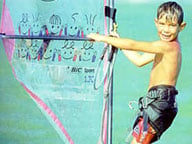
Reality:Windsurfing is only difficult to learn if the learner has insufficient information. Modern boards are designed for stability and ease of use. Boards have become much wider, lighter, and more durable over the years. Most beginners should learn in light to moderate wind (5-15 mph), on a large 'floaty' board with plenty of volume, and a small sail. Also, learning to windsurf without knowing about the fundamentals can be frustrating and exhausting – this is when lessons, a good instructor, and possibly a video will go a long way to get you sailing in a short time. Most windsurfing students with a good instructor will be able to windsurf on their own by the first or second session on the water.
Myth: Windsurfing is physically demanding.
Reality: Men, women, and children of all ages, body types, and levels of strength can windsurf in a variety of conditions. In windsurfing, the sail and rig can easily dump the wind if you begin to feel over powered. An instructor or windsurfing shop can evaluate your body type and help you decide on the right sail size for you. The sail can also be adjusted for maximum power or minimal power while setting-up (rigging) on the beach. With proper technique and practice you will find that you gracefully dance with the wind rather than wrestle with it.
Myth: Windsurfing is a dangerous sport.
Reality: Any sport can be dangerous, but most beginners are nervous about being on the water, or the power of the wind intimidates them. Remember - the windsurf board itself serves as a flotation device. Stay with the board and even if you forgot your life jacket you can hang onto your board for support, or sit on top of it to rest. Impact damage is another fear as windsurfing can be a very speedy sport. In the event of a wipe-out you are unlikely to impact anything but water. If your mast or rigging falls in your direction your hands and arms should protect you by default. Such an impact is very rare; the wind will tend to blow the sail away from you. Helmets in extreme conditions are sometimes a popular choice. Ultimately, you have great control over how the board and rig react.
Myth: Windsurfing is expensive.
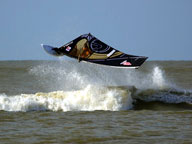
Reality: Compared to most water sports, windsurfing is relatively inexpensive. Unlike power-boat sports (like jet skiing, wake boarding, or water skiing), you do not have to pay for fuel, registration (in most states), insurance, or endless maintenance. Your fuel is clean and completely renewable - the wind! Most windsurfers will own one or two boards, and one to three sails for many years without needing to buy new equipment. Boards today are designed to cover a wide range of conditions; this is a throwback to the 80's when windsurfing was most popular. Today the idea is to own an all-around board (like the Exocet Kona or Bic Techno 293) when you first begin, which will keep you busy indefinitely until you can move on to something more extreme or specialized.
Myth: You can only windsurf where there is coastline and a beach.
Reality: The most popular places to windsurf are inland lakes. Coastline gets the spotlight because of the variety of conditions and high winds found there, but not everyone can take time to drive to the nearest coastline.
Myth: Windsurfing is mostly slow and leisurely, like boat sailing.
Reality: Windsurfing can be slow and leisurely in light winds on a large board. But, the most radical windsurfing takes place in heavy surf, rough chop, or high winds on flat water where sailors routinely reach speeds near 40 mph.
Myth: Windsurfing is mostly a fast and radical sport, like surfing.
Reality: Windsurfing can be fast, wet, and wild. But if you are looking for a relaxed cruise on the lake break out your long board, or any large floaty board that does well in light wind, and you will be fine.
Local Myth: There is no wind in North Texas.
Reality: Certainly the best places to find wind in Texas are the Panhandle, and the Texas Coast. Closely after the Texas Coast is North Texas. Like the Texas Coast, the pressure variance between cool gulf air and the warmer air on land draws the wind to the north, mostly in the spring and fall (although not as much in fall). Unlike the coast in North Texas there is much more storm activity from the southwest, west, and northwest, creating gusty conditions. Sometimes this works to our advantage, sometimes not. Either way, the winds in North Texas are some of the best in Texas.
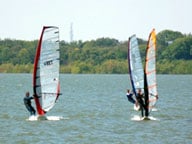
Local Myth: The Dallas/Fort Worth Area has a small windsurfing community.
Reality: With an active windsurfing club, several events throughout the year, and a consistent windsurfing presence on local lakes, the DFW area has a windsurfing community that is one of the largest in Texas, if not the largest. The only other community that is comparable is the one in the Corpus Christi area. However Corpus Christi is more of a windsurfing destination, not a place where a lot of windsurfers reside permanently. The windsurfing community here is exceptionally friendly. The community wants to see more people out on the water. Therefore there is ample encouragement and support for beginners.
Where to Windsurf in North Texas
The Dallas/Ft Worth metroplex is surrounded by several large lakes. All of these lakes are man made and have launch points with room to rig up your board and sail. A great resource for information on launch spots is the North Texas Wind Rider's website at www.ntwr.org. There you will find a map and guide to launch points in detail. Here are a few of the most popular places to windsurf in the area.
Lake Ray Hubbard, east of Dallas on Interstate 30, is arguably the most popular place to windsurf in the area. Windsurf Bay Park is a well known learning spot. There is an enclosed bay about 2 miles across protected by curving rock jetties – if you have any trouble here you are likely to be able to get to a nearby shore safely.
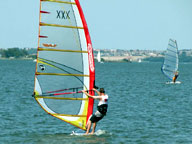
Lake Grapevine is northwest of downtown Dallas and just North of the DFW airport. It is the other popular lake for windsurfers; known for its steep banks and cliffs. There are a variety of places to launch on this lake, such as Rockledge Park and Oak Grove Park.
Lake Lewisville is a very popular lake for all manner of water sports. Despite its reputation as a dangerous lake due to boat traffic in the warm season, there are several good launch points such as Sailboard Point, Hobie Point, and Stuart Creek Park. Most powerboat traffic will stay off the lake in high winds. However it is advisable to be mindful of your surroundings.
Other Lakes: There are several other excellent lakes within an hour's drive of Dallas, such as Lavon, Ray Roberts, and Texoma. Some lakes in the inner city (such as White Rock and North Lake), are restricted to windsurfing for various reasons. If you are unsure whether a lake is restricted to windsurfing, it is always a good idea to contact Texas Parks and Wildlife for details.
Other Texas Destinations: One of the most popular places to windsurf in Texas is Bird Island Basin. It is located in the National Seashore approximately thirty miles south of Corpus Christi on Padre Island. This is an excellent place for all skill levels, including beginner, as you can easily touch bottom in most places. Another popular destination is South Padre Island – on the southernmost area of the Texas Coast. The winds there are perhaps the most consistent in Texas, and comparable to Bird Island Basin. Generally anywhere on the Texas Coast has consistent Gulf-driven wind. There are also many fine lakes in the Austin and San Antonio areas, such as Lake Travis and Canyon Lake. We cannot discount the areas on the border of Oklahoma and west – where the winds are very good approaching the Texas panhandle.
Learn to Windsurf
Learning to windsurf is generally considered much easier to learn than most extreme sports. There are a few things that are essential to a proper first lesson or sailing session.
-
A large, stable, 'floaty' windsurfing board - When you first learn your foot placement and balance tends to be uncertain – this is typical. A large board will help you to gain essential balancing skills without falling into the water every few seconds. This is usually dependent on the learner's body weight and size. Any board in the vicinity of two hundred liters of volume with a dagger board is adequate for most large adults.
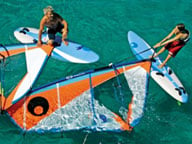
-
A small windsurfing rig (sail, mast, and boom) - To begin sailing you will need to 'uphaul' the rig, this means pulling the rig out of the water into an upright position. If you are just learning the proper techniques to uphaul your rig, you want something light and easy (generally something less than 5 square meters, and closer to 4 for small women, junior rigs for youngsters are also available). Larger sails also tend to be far more powerful and much harder to control. After you have learned the fundamentals of windsurfing you can move to a larger rig easily.
-
Life vest and foot protection - For most of us, it is a good idea to wear a life jacket while beginning to windsurf. Even advanced sailors will often wear a life jacket, which can be of great help with certain techniques like 'waterstarting'. Most instructors will require that you wear one. The general rule of thumb is to always stay with your board. Should your board somehow get away from you, your life jacket will be your fail-safe. In strong currents it is sometimes impossible to swim fast enough to catch the board if it floats away. Water shoes will prevent you from injuring your feet on hidden obstacles like shells or broken glass. Also, if the water is very cold hypothermia can be a danger, be sure to have a wet suit if necessary.
-
Instruction - Instruction in some form or another is usually required. Official lessons are the best. An experienced windsurfing instructor can help you master the fundamentals in a clear and easy way, and will usually provide gear that you can learn on. If you are unable to secure lessons, sign up for a windsurf clinic, and/or befriend an experienced, trustworthy windsurfer (preferably one with beginner equipment) to help you get started.
Where to Find Lessons
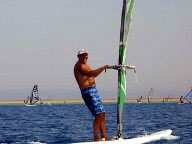
Learn to Windsurf Clinics - North Texas Windriders offers Learn to Windsurf Clinics every summer. Boards are provided by Mariner Sails and the local windsurfing community. Experienced NTWR members will spend time with those who want to try out a first lesson. Although the lessons are extremely basic, they will help you to determine if windsurfing is going to be something you enjoy.
Other Events - Keep your eye out for other upcoming events, such as the Texas State Championships and Windsurfing Festival. There are often beginner clinics offered at these events.
Types of Windsurfing
When windsurfing began its global meteoric rise to popularity in the late 70's and early 80's there was mainly one kind of windsurfing and one kind of board. Today the sport has evolved into several different branches and specialties. The type of windsurfing in which you will be most involved depends on your skill level, the local sailing environment, and the gear available to you.
Light Wind Cruising - When we refer to light wind we generally mean winds under about 15 mph or when a board is not on a plane. In this kind of wind you would sail a large, high volume, 'floaty' board, with a dagger board (also called a centerboard to help you point upwind easily. This is ideal for learning. You have time to decide what you want to do, recover from mistakes, and the rig is easy to control. Even advanced windsurfers often enjoy a nice, relaxing cruise in light wind.
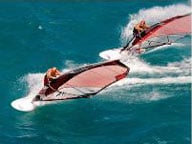
Race, Slalom, or Speedsailing - Simply put, go fast! The goal is to get your board hydroplaning, much like speed power boats, almost all boards are designed to skip over the water's surface while barely touching it, which means a great increase in speed. When intermediate windsurfers begin reaching planing speeds they discover a whole new and extreme sport, and this is often what hooks people into windsurfing for life. Certain boards are designed solely for this purpose (like Formula Race Boards). Turning and jumping is not usually the emphasis here, although some sailors need a lot of speed to do freestyle tricks.
Freestyle - If you get involved in freestyle windsurfing you will quickly be hearing terms like Vulcan, Spock, Duck Jibe, and Flaka. Simply put; radical mind-blowing tricks unlike any you will see in any other water sport. Many of these tricks can be performed in light or heavy wind. Most people (sadly including many windsurfers) have no idea what can be accomplished in windsurfing. To get an idea yourself, go to your favorite internet search engine or internet video archive, and search for 'windsurfing tricks', or 'windsurfing freestyle'. These tricks do not come easy, but require practice. If you have the right instruction (such as an ABK Windsurfing clinic), you may find you can do much more than you thought possible.
Bump & Jump - This is sailing in relatively high wind and moderately choppy conditions. On big lakes these conditions are not uncommon; they allow a windsurfer a nice playground of moving obstacles and ramps (in the form of waves). Intermediate and advanced sailors on small, light boards will find it easy to chop-hop, jump, and possibly throw in the occasional loop (aerial).
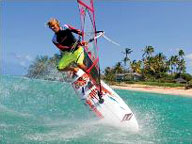
Wave Sailing - Wave Sailing is windsurfing in large waves and surf. It is a combination of surfing and windsurfing, where you will use the power of the wind (rather than paddle) to get into position, and then use a combination of wind and wave power to maneuver. The most radical jumping is found in wave sailing, and this is also the closest the sport gets to surfing. We also want to note that wave sailing is windsurfing at its highest of heights. Many sailors, including professional windsurfers, travel the world to find good wave sailing. Unfortunately North Texas is not Maui; there is no true wave sailing here. The best you can hope for in North Texas is good bump and jump conditions.
Other Types of Sailing - The difference between sailing styles is sometimes a fuzzy line. For this you will see 'Freeride' or 'One-design' boards that try to cover all the areas with as much versatility as possible. New types of sailing are bound to appear in the future.
Boards & Gear
When windsurfing first began there was little deliberation in choosing a board. With only one or two types of boards available there could be no indecision. Now with hundreds of different boards available, and several generations of board evolution, choosing a board can sometimes be daunting. If you are a beginner things can be simplified down to a few basic features to look for.
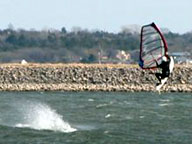
Choosing Your First Board: One feature of your first board should be stability. The best determination of stability is not so much length and width but volume. Volume is how much space the board would displace when placed in the water, as well as a determiner of how 'floaty' the board will be. Most beginners of large stature can easily find stability on a board in the vicinity of 200 liters.
Smaller sized people, like children or women weighing under 140 lbs, can often do well on boards with volumes as low as about 160 liters. However, there are many factors that do not make these numbers absolute, such as your sense of balance. Balance is something that will come with time even if you feel you have none.
Wide boards are considered more forgiving for uncertain foot-work, and are great for your first session on the water. However, some will make the argument that wide boards are so forgiving that they do not allow you to correct bad habits. For this reason many beginners will have their first lesson on something extremely wide, and when the fundamentals are learned they will get something a little more narrow. Ultimately it will depend on your comfort level. Ask an instructor, windsurfing shop, or experienced windsurfer about beginner boards for details on which is best for you.
Moving to Other Boards: You have mastered the fundamentals of sailing in light wind, you are sailing in moderate to heavy wind, you are using the harness lines, you are able to turn confidently by tacking and sometimes jibing, and you are ready to look for something faster, more specialized, and more extreme.
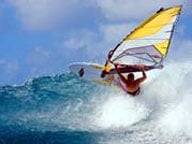
Sometimes people believe they are ready to move onto an intermediate board after their first lesson, and occasionally they are right, but you must ask a few questions first:
-
if you lose the wind will the new board get you home easily?
-
will you be able to stand on the board and uphaul the sail, or will you have to learn the skill called 'waterstarting'?
-
will this board perform at all in lighter winds?
-
where and in what conditions will you be sailing this board?
Some people make the mistake of choosing a board that is far too extreme for their skill level and environment. For example, what use is getting a small and relatively unstable wave or slalom board that only performs in winds over 20 mph, and the winds rarely reaches the optimum speed in your area? Time on the water (not board configuration) is the best way to progress to higher levels – so choose a board that will allow you to spend more time on the water and establish skills with confidence.
Boards Types
Fun Boards refer to large, wide, and stable boards that are ideal for beginners. These are modern boards, usually come with a dagger board (centerboard), very wide (usually about a meter), and they have volumes in the vicinity of 200 liters. Modern fun boards are designed to establish a plane early, which means a great burst of increased speed. They are ultimately not as fast as long boards in light wind, and slower than race or slalom boards in high wind. Jumping or maneuvering in large waves is not the emphasis here.
Freeride Boards are designed for some speed but otherwise do not fit into any one specialty - to ride freely is the idea. This is popular among intermediates who want a board that can do a little bit of everything. Freeride boards range in volume and size.
Long Boards were most popular in the eighties and early nineties, but have seen a recent resurgence among beginners and racers. They are generally longer than eleven feet, much narrower than a fun board, and come with a dagger board. Long boards are faster than other boards in non-planing or light wind conditions. They can be very fast once a plane has been achieved, but it takes longer for them to reach a plane than most modern boards. Some long boards, like the Kona One and RRD Longrider, are once again becoming popular on the modern market.
| Fun Boards | Freeride Boards | Long Boards |
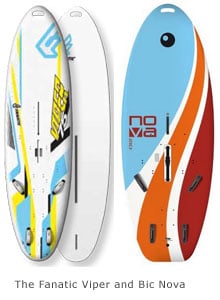 |
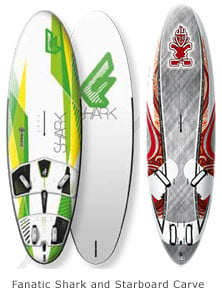 |
 |
Slalom and High Speed Boards are designed for speed. They sometimes cross the line as race boards, however they do not achieve a plane as easily as a most race boards such as Formula race boards. They are usually small, light, and narrow.
Formula Race Boards are distinctive race boards that made their first appearance at the turn of the century. They are wide, with a blunt nose and a hard-edged tail. They are light and designed to achieve a plane in wind as little as about ten miles per hour. Formula boards are considered great performers while on a plane, however somewhat lacking in speed and responsiveness if not on a plane. These are purely for speed and racing, turning and maneuvering are not the emphasis here.
Hybrid Race and One Designs - to correct some of the drawbacks of the Formula Race Boards, in recent years hybrid boards have appeared in the racing scene. They are a combination of the Formula design with a somewhat wide body and blunt nose, but also come with a dagger board. This allows for better performance when not on a plane. Additionally, this allows for better performance in a much wider variety of conditions. They are now the board of choice for Olympic racing. These boards are also popular with beginners who want a board that will let them easily progress to intermediate stage.
Wave Boards are designed to use wave power to generate forward drive (much like surfboards), maneuver easily for cutbacks and quick turns, and jump. Most wave boards need a lot of wind for optimum performance. They are small with little volume, and certainly not for beginners. Wave boards come in a variety of designs; some have multiple fins (often called thrusters), an irregular shape (this was tried for a while in the early 90's), and some are wide while others are somewhat narrow. They all turn well, and although they can be very fast they are not designed to be speed or slalom boards.
| High Speed Boards | Formula Race Boards | Hybrid Race Boards | Wave Boards |
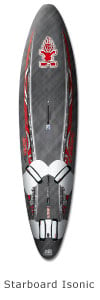 |
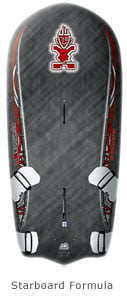 |
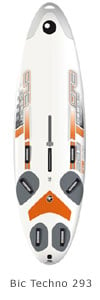 |
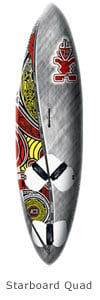 |
Other Boards - as long as windsurfing exists there will be boards that do not fit into any category at all. Some boards use a foil to elevate the board completely out of the water. There have been boards that are cylindrical or torpedo shaped. There are a variety of custom made boards; they perform according to the designer's whims. Unless you are an expert in board design or windsurfing, one rule of thumb when examining a board is to go with what is well established and proven.
Popular Boards for North Texas - the wind in North Texas can often be shifty and gusty. This is why the smallest boards (about 100 liters or less in volume) will only make an appearance on those rare days when the wind consistently blows over 20 mph. The best boards for this area are ones that can maintain speed through the lulls, establish a plane early, and perform on flat to moderately choppy water. Therefore you will see a great deal of fun boards, long boards, freeride boards, Formula race boards, hybrid race boards, and occasionally high speed slalom boards. The presence of wave boards on the local lakes is rare and often a fluke (but some people do sail them).
Sail Types
The sail type is just as important as the board type. Sail sizes can range from two square meters up to twelve or more. The right sail size will depend on the sailor’s size and the conditions. It does no good to have a large twelve sq.m. sail in thirty m.p.h. winds if it is uncontrollable, just as a small sail can leave you lagging behind your buddies. It is also important that the boards fin is not too small for the sail (this causes spinout), or too large for the sail (this can cause instability). To briefly summarize, most sails will come in three categories: race, wave, and freeride.

Race Sails are very full towards the bottom. They are designed for lower-end control and to pull through lulls in the wind. They commonly come with cambers which help the sail hold its shape.
Wave Sails are designed for surf or heavy chop. They catch wind a bit higher in the air, and the bottom of the sails rise high to clear the water. They are easy to flip, but do not usually come with cambers.
Freeride Sails cover anything between race sails and wave sails.
Other Sails - just like boards, there are a wide variety of sails that do not fit into any one category. When choosing a sail, go with something that is in great shape, and proven in the industry,
Information & Links
Windsurfing Products at Mariner Sails
North Texas Wind Riders - local DFW windsurfing association for launch site info, forums, and local events.
Austin Windsurf Club - Austinites often travel here to sail and visa versa with a healthy community.
Corpus Christi Windsurfing Association - a mecca for windsurfing in the continental U.S. is Corpus Christi.
Windsurfquest.net - windsurfing launch site guide with social interactive tools for local communities.
Windsport Magazine - great source for information.
Glossary of Windsurfing Terms
Batten – a long, flat rod, usually plastic, that slides into the sail structure to add rigidity and shape to the sail.
Beach Start – a technique for stepping onto the board in knee deep water while holding onto the rig.
Boom – the boom is what the sailor holds and controls the rig with. It fits across the sail and latches onto the mast.
Booties – water shoes that provide protection against dangerous objects.
Centerboard – the retractable wing shaped board or elongated fin that is inserted into the center of the windsurf board and provides stability for the board. Also commonly referred to as the dagger board.
Center line – the imaginary line that runs through the center of the board from front to back. The center line is often emphasized when learning new techniques.
Clew – the back corner between the bottom and the back of the sail, this is where the outhaul line is threaded.
Dagger Board – the center board. Technically a dagger board must be pulled or pushed straight up or down to be extended or retracted unlike a centerboard, which extends and retracts from a hinge. In windsurfing they are usually referred to as the same. True dagger boards are now obsolete in windsurfing.
Downhaul – the amount of downward tension on the sail – this affects the mast curvature, sail shape, and ultimately the power of the sail. This also refers to the line that runs from the lower end of the sail into the pulleys and cleats in the mast extension.
Down Wind – the direction the wind is blowing, opposite of upwind.
Fin – the plastic or fiberglass wing that is mounted on the bottom of the tail of the board. Fins come in a variety of shapes and affect how the board maneuvers.
Fin Box – the slot in the back of the board where the fin is inserted.
Foot Strap – the nylon straps near the back of the board. When establishing high speeds the sailor inserts his/her feet into the straps which allows for even greater speeds while sailing on a plane.
Gybe – one in the same as a jibe. This is a 180 degree turn across the downwind direction.
Harness-line – these lines attach to the boom and hook into the harness that the windsurfer is wearing. This allows the sailor to use his body weight (rather than just the arms) to control the sail and achieve more speed.
Head – the section at the very top of the mast and sail.
Jibe – to turn across the downwind direction (across the 6 o'clock).
Leech – the back edge of the sail.
Ligon Stick - a versatile piece of technology, consisting of a carbon-fiber stick resembling a small club. This stick is used to bludgeon windsurfing salesmen who have not yet grasped political correctness, diplomatic service, and mature behavior. Affectionally designed for Ligon Krohn.
Luff – the front edge of the sail from the foot of the mast to the head or top of the sail.
Mast – the long rod that goes through the sail to give the sail its basic shape – modern masts are made from a combination of carbon and fiberglass.
Mast Extension – this cylinder slides into the bottom of the mast. It is adjustable to alter the mast length for different sail sizes.
Mast Base – the base of the mast, this assembly fits into the mast extension, contains the U-joint, and locks onto the board.
Mast Sleeve – the section of the sail where the mast is inserted. Also called the luff sleeve.
Off-shore – this refers to wind that is blowing away from the shoreline.
On-shore – this refers to wind that is blowing into the shoreline.
Outhaul – 1] the amount of outward tension on the sail. 2] the line that is threaded at the back of the boom through the sails clew (back corner).
Plane – when a watercraft skips speedily over the surface of the water with a minimal area of the hull touching the surface.
Rail – the edges of the board, the softness or hardness of the rail determines how the board performs.
Rig – 1] the assembly that consists of the sail, mast, and boom. 2] to prepare your gear for sailing.
Sailboard – often considered one in the same as a windsurf board.
Sail – 1] the plastic or nylon sheet that captures the wind for propulsion. 2] in windsurfing, this is the same as 'to windsurf'.
Sailor – in windsurfing, this is synonymous to someone who windsurfs.
Sheet-in – to pull the sail inward from the trailing hand.
Sheet-out – to let the sail outward from the trailing hand – usually to dissipate sail power.
Side-shore – this refers to a wind that blows parallel to the shore – this is considered optimum in most cases.
Slog – when a board designed for planing is not on a plane, but slowly plows through the water.
Tack – to establish a turn in the opposite direction by turning across the upwind direction.
U-joint – the universal joint; this joint at the mast base allows the rig to pivot in any direction, and is what makes windsurfing possible.
Uphaul – 1]to pull the rig out of the water. 2] the line attached to the boom used to pull the sail out of the water.
Volume – the amount of space the board displaces when placed in the water and a determiner of how easily the board floats. Volume is measured in liters.
Waterstart – a technique for getting onto the board in deep water by allowing the rig to pull the sailor onto the board.
